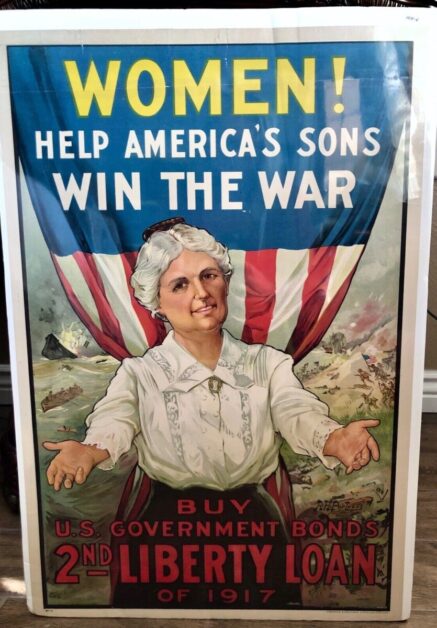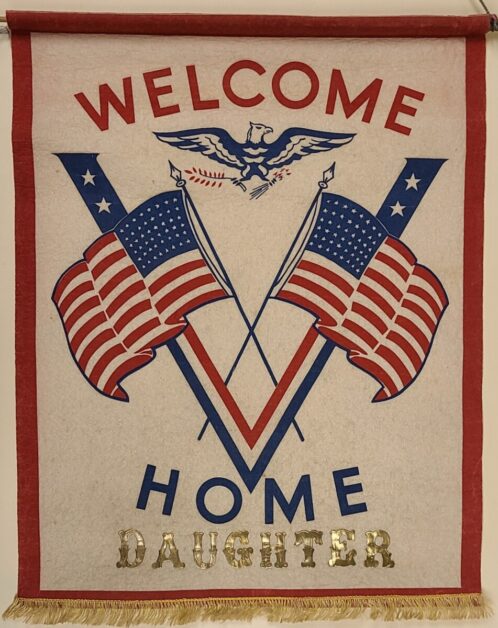MANUSCRIPTS
THREE WWI ERA POSTERS
Three recent additions to the 20th Century Poster Collection include these World War I era posters demonstrating the role women played in supporting the war efforts. From left to right, “Women of America Work for Victory,” which depicts “Columbia” as participating in the home canning work promoted by the National War Garden Commission, “Red Cross Christmas Roll Call: Where Columbia Sets Her Name, Let Every One of You Follow Her,” and “Women! : Help America’s Sons Win the War,” created to promote the Second Liberty Loan of 1917.



Three World War I Era Posters
The Lelia Judson Tuttle Papers and Chinese Artifacts Addition
Tuttle’s great-grandson donated additional materials related to Tuttle’s time teaching in China, including correspondence, monographs, pamphlets, photographs, textiles, and artifacts.

RARE BOOKS
EDWARD GOREY’S TUNNEL CALAMITY
Edward Gorey brought his wit to life in Tunnel Calamity, originally published as one of the Magic Windows Books™ by G.P. Putnam’s Sons in 1984. The Magic Windows books were marketed as “A Series of Extraordinary Scenes in Three Dimensions”, an apt format for Gorey’s ominous art. What exactly is this calamity – why it is the “unexpected appearance of the ULUUS (thought to have been extinct for over a century) in the tunnel connecting East Shoetree and West Radish, St. Frumble’s Day, 1892.” This accordion tunnel book has a cello window pane on the front cover to allow the viewer to explore the interior scene.


Interior and Exterior View of Tunnel Calamity
EARLY CHILDHOOD EDUCATIONAL INTERACTIVE SPECIMEN
F. N. Paris was a publisher of French games and novelties active in the late 19th and early 20th centuries. Many of their games had educational themes that helped developed manual skills in children. Paper weaving was one of the most popularly practiced Froebel Gifts, but the proliferation of die cut puzzles at the turn of the century made these fragile endeavors a short-lived fascination. This is “Pochette No. 1,” ostensibly from a series illustrating Aesop’s fables. The images are printed using the chromolithograph method and then cut to form the strips for weaving.

Tissage Imagé / [Pictorial Weaving]: Le Renard et La Cigogne & Le Loup et l’Agneau
MORRIS COX, POET
Morris Cox is now most well-known for the books he created with Gogmagog Press, which he printed on a modified table top press in his home. Cox was also a graphic artist, a painter, a sculptor, and a poet. It is from this creative outlet that he and four other poets began the little magazine, Format. In the inaugural issue, they describe the impetus behind this publication:
There is no shortage of little magazines for poets writing in English, whatever their style. But from the point of view of the poet it all takes too long. The four contributors to this issue all work for a living. Our leisure time is short, as is most peoples’. We feel the need for a clearing house for our current work, so that it will stop nagging at our minds, and leave us free to move on. We also feel that the limited space available in the established “Little Mags” leads to impossible questions of choice. Hence FORMAT, which will be published whenever any of us has enough material to make an issue worth while, based on an ideal of three per year.



Issues Numbered 1 – 3 of Format
TREE OF CODES / JONATHAN SAFRAN FOER
One of only five proof copies issued of Foer’s critically-acclaimed sculptural object / artists book, based on his cutting-away of most of the words from Bruno Schulz’s influential book The Street of Crocodiles to form a new narrative object. The five proof copies were issued in plain stiff white wraps, with printed wraparound pastedown label. This copy has wear to covers and some minor wear to text; there are two ink squiggles on front cover that could possibly be signatures.


Cover and Interior Page of Tree of Codes
WOMEN VETERANS HISTORICAL PROJECT


71 issues of the U.S. Naval Reserve Newsletters, 1949 and 1946-1955. The newsletters include articles and announcement about the Navy WAVES.





1943 Paper Dolls Women’s Army Corps and Navy WAVES, Whitman Publishing. The paper outfits include selections of both civilian outfits and military uniforms.

UNIVERSITY ARCHIVES
Photograph of Lula Martin McIver

This photograph of Lula Martin McIver was found by librarians at Alamance County Public Libraries among the family photos of the late Deroy Fonville of Burlington, North Carolina. Knowing that it would be a meaningful addition to the University Archives Historic Print Collection, they donated it to the Martha Blakeney Hodges Special Collections and University Archives. Lula Verlinda Martin McIver was the wife of the school’s founder, Charles Duncan McIver. Although her husband passed away in 1906, she continued to live in their family home on campus until her own death in 1944.